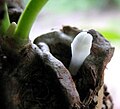pt-BR
nomes no trilho de navegação


Myrmecodia beccarii, ant-house plant, is an epiphytic plant on Melaleuca trees and others with spongy bark in the wetlands and mangroves of tropical north Queensland, Australia from Cooktown to Mission Beach. The prickly, swollen stems develop natural hollows which are invaded by the golden ant (Iridomyrmex cordatus) in a symbiotic arrangement. The ants patrol the plant, removing leaf-eaters, while their excreta is absorbed by the plant for nutrition.[1]
The flowers are white and tubular, to 10 mm, and the fruit is white/translucent containing a single seed. These seeds are transported to other trees by the mistletoebird (Dicaeum hirundinaceum).[2]
The Apollo jewel butterfly (Hypochrysops apollo apollo) lays its eggs on the plant, and because they smell like ant's eggs, the ants carry the eggs inside the plant, where they develop to the butterfly stage. Hypochrysops is a genus of "blues", butterflies in the family Lycaenidae, which is notorious for its myrmecophily. Accordingly, it is likely that the larvae that hatch from the eggs feed either on food begged from the ants, or on ant larvae, or possibly both. In either event, the butterfly finally emerges and flies off.[3]
Myrmecodia beccarii, ant-house plant, is an epiphytic plant on Melaleuca trees and others with spongy bark in the wetlands and mangroves of tropical north Queensland, Australia from Cooktown to Mission Beach. The prickly, swollen stems develop natural hollows which are invaded by the golden ant (Iridomyrmex cordatus) in a symbiotic arrangement. The ants patrol the plant, removing leaf-eaters, while their excreta is absorbed by the plant for nutrition.
The flowers are white and tubular, to 10 mm, and the fruit is white/translucent containing a single seed. These seeds are transported to other trees by the mistletoebird (Dicaeum hirundinaceum).
The Apollo jewel butterfly (Hypochrysops apollo apollo) lays its eggs on the plant, and because they smell like ant's eggs, the ants carry the eggs inside the plant, where they develop to the butterfly stage. Hypochrysops is a genus of "blues", butterflies in the family Lycaenidae, which is notorious for its myrmecophily. Accordingly, it is likely that the larvae that hatch from the eggs feed either on food begged from the ants, or on ant larvae, or possibly both. In either event, the butterfly finally emerges and flies off.

flower

fruiting
Myrmecodia beccarii Hook.f. è una pianta mirmecofila epifita della famiglia delle Rubiacee, nativa dell'Australia.[1]
L'epiteto specifico è un omaggio al botanico italiano Odoardo Beccari (1843-1920).
È una specie epifita caratterizzata da una tuberosità basale grigio-brunastra, irregolarmente cilindrica, di circa 30 cm di lunghezza, ricoperta da corte spine, al cui interno si sviluppa un sistema di cavità che comunicano con l'esterno attraverso minuscoli fori.[2]
Da ogni tubero si sviluppano uno o più fusti lunghi sino a 15 cm, da cui si dipartono le foglie, ellittico-lanceolate, succulente, lunghe 1–9 cm, sorrette da un corto picciolo.
I fiori, poco appariscenti, lunghi circa 1 cm, sono bianchi, con antere blu. Il frutto è anch'esso bianco, lungo poco più di 1 cm.
M. beccarii ospita all'interno della sua base tuberosa colonie della formica Iridomyrmex cordatus (Dolichoderinae) con le quali ha un rapporto di simbiosi mutualistica: le formiche difendono la pianta dagli insetti fitofagi, e forniscono alla pianta sostanze minerali nutritive, contenute nelle loro escrezioni.[3] A tale relazione simbiotica partecipano in qualche maniera anche le larve della farfalla Hypochrysops apollo apollo (Lycaenidae), le cui uova vengono ospitate dalle formiche all'interno della pianta, dove si sviluppano, sino allo stadio di immagine, nutrendosi delle scorte di cibo del formicaio ma anche dei tessuti della pianta. La esatta natura di questa interazione non è stata ancora chiarita: potrebbe trattarsi di semplice parassitismo o ancora una volta di mutualismo.[4]
La specie è diffusa nelle aree costiere del Queensland (Australia), tra Cooktown e Ingham.[2]
Cresce in foreste dominate da Melaleuca viridiflora e nelle mangrovie.
La specie non rientra tra quelle valutate dalla Unione Internazionale per la Conservazione della Natura (IUCN).
L'Environment Protection and Biodiversity Conservation Act 1999 (EPBC Act) del governo australiano la classifica come specie vulnerabile.[5]
Parte del suo areale ricade all'interno del parco nazionale Girringun, del parco nazionale Daintree e del parco nazionale Edmund Kennedy (Tropici del Queensland).[2]
Myrmecodia beccarii Hook.f. è una pianta mirmecofila epifita della famiglia delle Rubiacee, nativa dell'Australia.
L'epiteto specifico è un omaggio al botanico italiano Odoardo Beccari (1843-1920).
Myrmecodia beccarii là một loài thực vật có hoa trong họ Thiến thảo. Loài này được Hook.f. mô tả khoa học đầu tiên năm 1886.[1]
Myrmecodia beccarii là một loài thực vật có hoa trong họ Thiến thảo. Loài này được Hook.f. mô tả khoa học đầu tiên năm 1886.